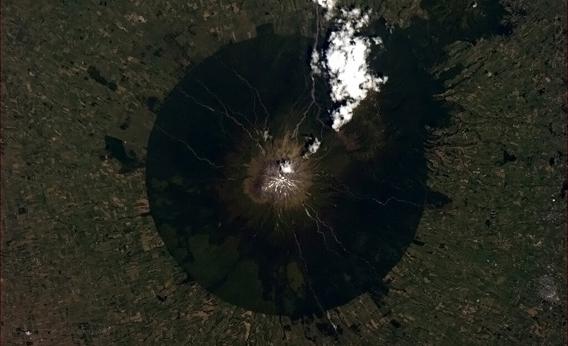Create a free profile to get unlimited access to exclusive videos, sweepstakes, and more!
A Perfect Cone [CORRECTED]

[Correction, Feb. 16, 21:00 UTC: I have a correction to make in the article below. Normally, Slate's policy is to label the offending part and then correct it at the bottom, but it turns out a lot of the article was based on that error, so it's a bit hard to label the places I was wrong. Plus, the mistake also reminded me of a lesson about science itself which is worth telling you up front.
In the following post, I thought the Mt. Taranaki, pictured below, had a perfectly circular flank. From the photo, that's an easy assumption to make. Also, I looked up info about the volcano on various websites, and what I read reinforced that ideaâ¦but only because I already had that idea in my head.
But, in fact, the circular nature of the volcano is an illusion; in reality a circular region centered on the peak has been made into a National Park with a radius of 9.6 kilometers (6 miles), and that's what you see in the photo.
But, because I had the idea in my head that the volcano itself was such a lovely shape, I read those other sites and the idea got nice and stuck in my brain. People in the comments below and via email let me know I was wrong, and I thank them for it. What's funny to me is that in the post itself I express some skepticism that you could get such a circular volcano via dome collapse, which generally makes asymmetric cones.
I should've trusted my scientific instincts.
The point: We all make mistakes, some big, some small, and it's easy for even people experienced in the ways and means of skepticism to get their wrong ideas reinforced. I'm glad I got this reminder, and I sincerely hope that others can also get a kick in their cerebrum from this, too.
I have left the post itself intact, to show where and how I went astray. Enjoy, and remember: You may not know what you think you know.]
If I hadnât devoted my life and brain to astronomy and space, I wouldâve been a geologist. This revelation came upon me when I started collecting meteorites a few years back, around the same time I became fascinated by asteroid impactsâyou may see how all these are related. To cement the feeling, I also happened to visit a few volcanoes here and there, and fell heels over head in love with geology.
So nothing makes me giddier with delight then when all these factors come together, especially when it involves pictures of volcanoes from space. Theyâre all pretty amazing, but one came up recently that really surprised me: Mount Taranaki in New Zealand as seen by Chris Hadfield, an astronaut on the International Space Station:
Thatâs amazing: I didnât know volcanoes ever got such perfectly circular flanks! The symmetry is astonishing, and in fact is Taranaki is one of the most circular volcanoes on the planet. I was surprised to learn that it has suffered several cone collapses over time; this is what happened with Mount St. Helens in 1980, and I would think that would lead to an asymmetric cone. When the cone collapses on a volcano, an explosion to the side is frequently the result. This is one of those times when I feel a strong desire to sit down with good, solid book on volcano formation.
Emily Lakdawalla with The Planetary Society found a gorgeous shot of Taranaki taken by the Landast satellite, and also pointed to a fun âwiggle shotâ of the volcano: an animated GIF that rapidly blinks between pictures taken at two slightly different angles, giving an illusion of depth. It might make you a little queasy, but the 3D feeling is striking.
Taranaki is an active volcano, with small eruptions happening every century or so, and major eruptions roughly every 500 years. Thatâs not a schedule the volcano follows religiously, but on average is the way to bet. The last big eruption was in the middle of the 17th century, so volcanologists are keeping an eye on it. Note in the picture that the volcano is surrounded by farmland; the different colors to the fields separated by straight lines is a dead giveaway for that. That means there are people there, and the local economy depends on knowing what Taranaki is up to.
Itâs another obvious, and gorgeous, example of what science does for us. A lot of people donât necessarily see the connection between astronomy and their daily livesâand itâs there, all the timeâbut with pictures like this, making the case for geology is pretty easy.


























